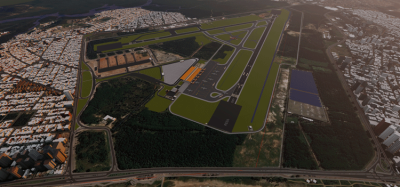Airport Profile: Hamburg – an international success story
- Like
- Digg
- Del
- Tumblr
- VKontakte
- Buffer
- Love This
- Odnoklassniki
- Meneame
- Blogger
- Amazon
- Yahoo Mail
- Gmail
- AOL
- Newsvine
- HackerNews
- Evernote
- MySpace
- Mail.ru
- Viadeo
- Line
- Comments
- Yummly
- SMS
- Viber
- Telegram
- Subscribe
- Skype
- Facebook Messenger
- Kakao
- LiveJournal
- Yammer
- Edgar
- Fintel
- Mix
- Instapaper
- Copy Link
Posted: 17 June 2014 | Michael Eggenschwiler, CEO of Hamburg Airport Group | No comments yet
Over the past few years, Hamburg Airport has gone from strength to strength, culminating in it being crowned Europe’s Best Airport. Michael Eggenschwiler, CEO of Hamburg Airport Group, reveals the airport’s journey.
When we start composing Hamburg Airport’s annual report each year we find ourselves talking about stable growth and about recognition. It isn’t just the language of annual reports, though: growth and awards are a good way to summarise the airport’s recent history.
The latest honour to come our way, announced in February 2014, was that of Europe’s Best Airport for 2013 – as judged by customers of eDreams, one of Europe’s largest online travel companies. Similar honours came in 2011 and 2012 when passengers chose us as Europe’s Best Non-Hub Airport in the Skytrax World Airport Awards. But the eDreams survey includes airports of every size, including the biggest hubs, and Hamburg was not only ranked number one in Europe but also number four worldwide.
Of course, an airport will never become popular if nobody flies there, and Hamburg’s many awards in recent years have been accompanied by steady growth, diversification in the route network and a focus on more service to our customers. There are now around 120 non-stop destinations served by 60 different airlines. Seats to 100 of those destinations can be booked for €100 or less. Three of Europe’s most important point-to-point carriers – Germanwings, norwegian, and easyJet – are all actively driving route growth in Hamburg, with other carriers such as Vueling, Germania, and SAS expanding their operations to and from the metropolitan area.
Since taking over Lufthansa’s non-hub short-haul operations in 2013, Germanwings has significantly expanded its route network from Hamburg, adding seven new year-round destinations in the latest timetable along with seasonal services to Zagreb, Zadar, and Pula. The Germanwings non-stop network from Hamburg now covers 47 destinations.
Scandinavia’s low-cost carrier, norwegian, is continuing to expand its network between Hamburg and Spain, adding non-stop Madrid and Barcelona services to its existing operations to Alicante, Gran Canaria, Malaga, and Tenerife.
Perhaps the most noteworthy route expansion in the past couple of years, however, has been easyJet opening a new base at Hamburg Airport. The airline has been flying from Hamburg since 2005, adding Edinburgh and Rome to the existing services to Manchester, Gatwick, Luton, and Basel a year ago. Five new year-round routes opened on 31 March 2014, to Copenhagen, Nice, Milan, Venice, and Palma, with new seasonal destinations – Catania, Athens, Ibiza, Naples, and Kalamata – being added in the summer season, bringing easyJet’s Hamburg portfolio to 17 European destinations.
The fact that European route growth in Hamburg over the past years consistently involves multiple carriers is a key factor in the sustained and stable growth that has been maintained even during such turbulent years as 2013, despite the negative effects of Germany’s Aviation Tax on the domestic market. And this route diversification means that more and more people are experiencing what the airport has to offer, which helps to explain Hamburg’s continuing climb in the European passenger popularity stakes.
Many factors, of course, play a role in attracting route growth. One factor that is perhaps less widely known, however, is worth pointing out, because we believe that it is a key differentiator for Hamburg within Europe and is often mentioned by airlines: The many departments involved in opening a new route work together across organisational boundaries. Over the years, the Hamburg Airport Group has cultivated awareness throughout the company that without airlines flying to destinations, there is no future. This may sound obvious, but there is a natural tendency within any large organisation for the individual departments and functions to see their work as an end in itself.
This proactive teamwork has been very obvious in recent months, with ad-hoc teams being put together to ensure easyJet’s requirements can be satisfied in the preparations for the opening of the airline’s new base. From long-term crew facility allocation to interim options, from gate scheduling to check-in counter allocation, and from on-airport advertising to city-wide marketing campaigns, the various departments and companies within the Hamburg Airport Group, along with key players from the city’s tourist industry, have cooperated with enthusiasm, flexibility, and innovation to make ‘their’ easyJet base feasible and the launch a success.
The face of the airport to the airline in route growth, the Aviation Marketing team, is regularly praised by airlines for this customer-friendly approach, and the team is consistently successful in the Routes Awards, chosen by airlines, winning in 2009 and 2010 and achieving second place in 2012.
Modern airlines, however, are increasingly aware that their own success depends on the whole travel experience offered to passengers. Regardless of how cheap the fare may be, landing in the middle of nowhere does not enhance the passenger experience. And regardless of how well passengers are treated in the air, if the experience at the destination begins and ends with an inconvenient or obsolete airport, the passenger is not going to develop positive feelings for the carrier.
Teamwork for success in the airline business must go beyond establishing the route to ensuring an overall positive experience with convenience and feel-good factors all along the travel chain, and this is certainly a key factor motivating airline decisions for route expansion at specific airports, with network planners asking themselves: what does flying to/from Hamburg Airport do for our brand and our passenger loyalty? And how the passenger experience compares to alternative but equivalent markets?
The eDreams World’s Best Airport rankings are based on passenger surveys that include various aspects of the airport experience. Developments in Hamburg’s bar and restaurant choice have obviously gone down well, with passengers pointing out the variety, the service, and the cleanliness in particular.
From an already respectable 10th place worldwide in 2012, up against the globe’s biggest and best-equipped airports, Hamburg has risen to number two in the world for bars and restaurants, based on passenger recommendations. Only Hong Kong International Airport offers a better culinary experience.
Airport shopping, too, is an increasingly important factor in travel, especially for business travellers and weekend city breaks, two of the key segments in European aviation growth. With their established reputations for high-profile fashion and technology brands at unbeatable discounts, there are no surprises at the top three airport shopping destinations worldwide: Hong Kong, Dubai and Singapore. But number four globally – coming ahead of Zurich and only just edged out of third place by Singapore Changi – is Hamburg. London’s lauded Heathrow Terminal 5 came in at a relatively distant number eight, and Paris and New York’s airports didn’t feature in the top 10 at all. The spacious and inviting Airport Plaza in Hamburg – leading passengers from the central security checkpoint to their gates in just a matter of minutes – has clearly struck a chord in the hearts of Europe’s travellers.
Hamburg’s waiting areas were another area singled out by passengers in the eDreams rankings, coming in third overall. The flip side of waiting areas, of course, is the time it takes to get there. We’ve all experienced the nightmare of passing through security to see a sign telling us that we have another 20 minutes or even more on foot ahead of us just to reach our departure gate – if we walk quickly, that is.
One of Hamburg Airport’s most consistently emphasised USPs in recent years has been the catchphrase ‘Flughafen der kurzen Wege’ – ‘the airport with short walking distances’. But it is more than just a catchphrase; guiding every planning and construction decision for more than two decades. It’s just 20 metres from the check-in counters to the security checkpoint; the shortest such distance in Germany. From the airport’s new Radisson Blu Hotel to the departure gates is just 200 metres and there is a metro rail station just two floors below the check-in counters and security checkpoint.
But even before reaching the security checkpoint, passengers flying from Hamburg know how long – or, more often, how short – the waiting time will be. Estimated waiting times based on the current situation are published on the website and via the airport’s own mobile app in real-time. Combined with free WLAN throughout the terminals, this makes it even easier to savour the last moments with loved ones before going through security, without being anxious about a surprisingly long queue.
The real-time parking guidance system on the roads approaching the airport helps passengers and visitors know where to park, although with more than 9,000 spaces directly opposite the terminals this decision is getting easier all the time. And to be absolutely certain of finding a parking space and paying the best possible price for it, parking spaces in medium and long stay car parks can be reserved online in advance.
These features, and many other examples of a modern airport infrastructure, help explain why not only passengers but also the Airports Council International (ACI) itself acknowledge Hamburg’s place at the leading edge of the evolution of the European airport. In 2012 and 2013, Hamburg was named as Best Airport in Europe in the annual ACI Awards. Other aspects mentioned in the citations include Hamburg’s award-winning proactive approach to environmental protection and the attention paid to the needs of passengers with reduced mobility.
I began this article by saying that stable growth and popularity are defining features of the life of Hamburg Airport. The combination of efficiency, service, and infrastructure are key factors in driving network growth, and the growing network further supports the popularity of the airport. This positively interlocking cycle bodes well for the airport’s ongoing development in the European airports master class.
Biography
Michael Eggenschwiler has been CEO of Hamburg Airport Group since 2005. He was previously a partner in a Swiss management consultancy after two decades at Crossair and Swissair, where he rose to the Executive Board. A Stanford graduate and ACI Europe Board Member, Michael was also President of the German Airports Association (ADV) from 2007-2010.
If you would like to read more about route development, don’t miss our Routes Supplement in International Airport Review issue 4 (published July 2014) – subscribe today by visiting www.internationalairportreview.com
















